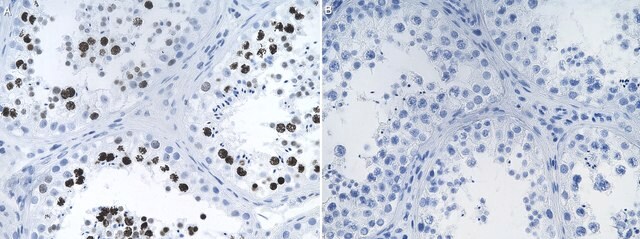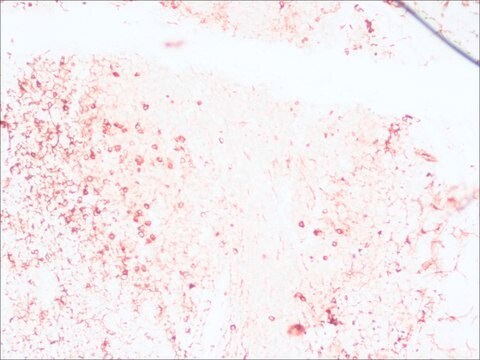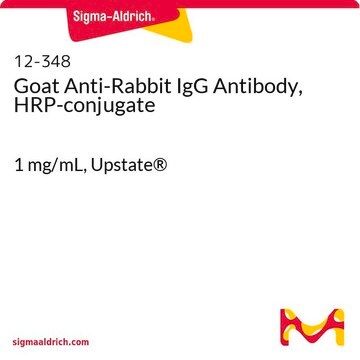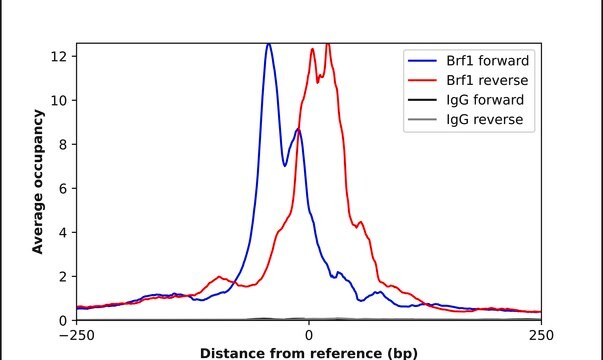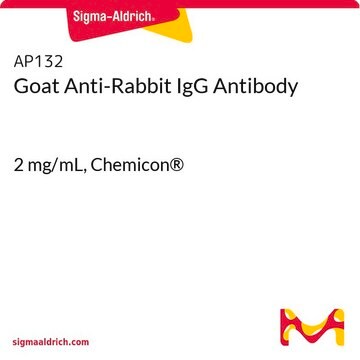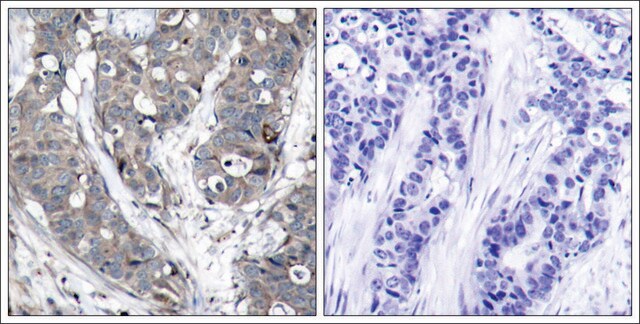추천 제품
생물학적 소스
rabbit
Quality Level
결합
unconjugated
항체 형태
affinity isolated antibody
항체 생산 유형
primary antibodies
클론
polyclonal
제품 라인
Prestige Antibodies® Powered by Atlas Antibodies
양식
buffered aqueous glycerol solution
종 반응성
human, rat, mouse
향상된 검증
independent
Learn more about Antibody Enhanced Validation
기술
immunoblotting: 0.04-0.4 μg/mL
immunohistochemistry: 1:500-1:1000
면역원 서열
LPLSQNQEFMPFVKELSEALTRHGVSHKVDDSSGSIGRRYARTDEIGVAFGVTIDFDTVNKTPHTATLRDRDSMRQIRAEISELPSIVQDLANGNITWADVEARYPLFEG
UniProt 수납 번호
배송 상태
wet ice
저장 온도
−20°C
타겟 번역 후 변형
unmodified
유전자 정보
human ... GARS(2617)
일반 설명
The gene GARS (glycyl-tRNA synthetase) is mapped to human chromosome 7p15. It belongs to aminoacyl-tRNA synthetases family of proteins. GARS is ubiquitously expressed.
면역원
Glycyl-tRNA synthetase recombinant protein epitope signature tag (PrEST)
애플리케이션
All Prestige Antibodies Powered by Atlas Antibodies are developed and validated by the Human Protein Atlas (HPA) project and as a result, are supported by the most extensive characterization in the industry.
The Human Protein Atlas project can be subdivided into three efforts: Human Tissue Atlas, Cancer Atlas, and Human Cell Atlas. The antibodies that have been generated in support of the Tissue and Cancer Atlas projects have been tested by immunohistochemistry against hundreds of normal and disease tissues and through the recent efforts of the Human Cell Atlas project, many have been characterized by immunofluorescence to map the human proteome not only at the tissue level but now at the subcellular level. These images and the collection of this vast data set can be viewed on the Human Protein Atlas (HPA) site by clicking on the Image Gallery link. We also provide Prestige Antibodies® protocols and other useful information.
The Human Protein Atlas project can be subdivided into three efforts: Human Tissue Atlas, Cancer Atlas, and Human Cell Atlas. The antibodies that have been generated in support of the Tissue and Cancer Atlas projects have been tested by immunohistochemistry against hundreds of normal and disease tissues and through the recent efforts of the Human Cell Atlas project, many have been characterized by immunofluorescence to map the human proteome not only at the tissue level but now at the subcellular level. These images and the collection of this vast data set can be viewed on the Human Protein Atlas (HPA) site by clicking on the Image Gallery link. We also provide Prestige Antibodies® protocols and other useful information.
생화학적/생리학적 작용
GARS (glycyl-tRNA synthetase) is responsible for addition of glycine to its related tRNA. GARS is also involved in production of diadenosine tetraphosphate (Ap4A), a signaling molecule for cell regulation pathways. Mutations in GARS are associated with axonal neuropathies: charcot-marie-tooth disease type 2D (CMT2D) and distal spinal muscular atrophy type V (dSMA-V).
특징 및 장점
Prestige Antibodies® are highly characterized and extensively validated antibodies with the added benefit of all available characterization data for each target being accessible via the Human Protein Atlas portal linked just below the product name at the top of this page. The uniqueness and low cross-reactivity of the Prestige Antibodies® to other proteins are due to a thorough selection of antigen regions, affinity purification, and stringent selection. Prestige antigen controls are available for every corresponding Prestige Antibody and can be found in the linkage section.
Every Prestige Antibody is tested in the following ways:
Every Prestige Antibody is tested in the following ways:
- IHC tissue array of 44 normal human tissues and 20 of the most common cancer type tissues.
- Protein array of 364 human recombinant protein fragments.
결합
Corresponding Antigen APREST74913
물리적 형태
Solution in phosphate-buffered saline, pH 7.2, containing 40% glycerol and 0.02% sodium azide
법적 정보
Prestige Antibodies is a registered trademark of Merck KGaA, Darmstadt, Germany
면책조항
Unless otherwise stated in our catalog or other company documentation accompanying the product(s), our products are intended for research use only and are not to be used for any other purpose, which includes but is not limited to, unauthorized commercial uses, in vitro diagnostic uses, ex vivo or in vivo therapeutic uses or any type of consumption or application to humans or animals.
적합한 제품을 찾을 수 없으신가요?
당사의 제품 선택기 도구.을(를) 시도해 보세요.
Storage Class Code
10 - Combustible liquids
WGK
WGK 1
Flash Point (°F)
Not applicable
Flash Point (°C)
Not applicable
가장 최신 버전 중 하나를 선택하세요:
Anthony Antonellis et al.
The Journal of neuroscience : the official journal of the Society for Neuroscience, 26(41), 10397-10406 (2006-10-13)
Charcot-Marie-Tooth disease type 2D (CMT2D) and distal spinal muscular atrophy type V (dSMA-V) are axonal neuropathies characterized by a phenotype that is more severe in the upper extremities. We previously implicated mutations in the gene encoding glycyl-tRNA synthetase (GARS) as
Francesca Achilli et al.
Disease models & mechanisms, 2(7-8), 359-373 (2009-05-28)
Mutations in the enzyme glycyl-tRNA synthetase (GARS) cause motor and sensory axon loss in the peripheral nervous system in humans, described clinically as Charcot-Marie-Tooth type 2D or distal spinal muscular atrophy type V. Here, we characterise a new mouse mutant
Muhammed Z Cader et al.
FEBS letters, 581(16), 2959-2964 (2007-06-05)
Dominant mutations in the ubiquitous enzyme glycyl-tRNA synthetase (GlyRS), including S581L, lead to motor nerve degeneration. We have determined crystal structures of wildtype and S581L-mutant human GlyRS. The S581L mutation is approximately 50A from the active site, and yet gives
S J Mudge et al.
Gene, 209(1-2), 45-50 (1998-05-16)
Glycine tRNA synthetase (glyRS) catalyses the addition of the amino acid glycine to its cognate tRNA molecules. In the silk moth worm Bombyx mori, this gene is subject to complex transcriptional regulation because of the predominance of glycine in silk.
Yun Chen et al.
Nucleic acids research, 46(7), 3643-3656 (2018-03-27)
TARS and TARS2 encode cytoplasmic and mitochondrial threonyl-tRNA synthetases (ThrRSs) in mammals, respectively. Interestingly, in higher eukaryotes, a third gene, TARSL2, encodes a ThrRS-like protein (ThrRS-L), which is highly homologous to cytoplasmic ThrRS but with a different N-terminal extension (N-extension).
자사의 과학자팀은 생명 과학, 재료 과학, 화학 합성, 크로마토그래피, 분석 및 기타 많은 영역을 포함한 모든 과학 분야에 경험이 있습니다..
고객지원팀으로 연락바랍니다.
